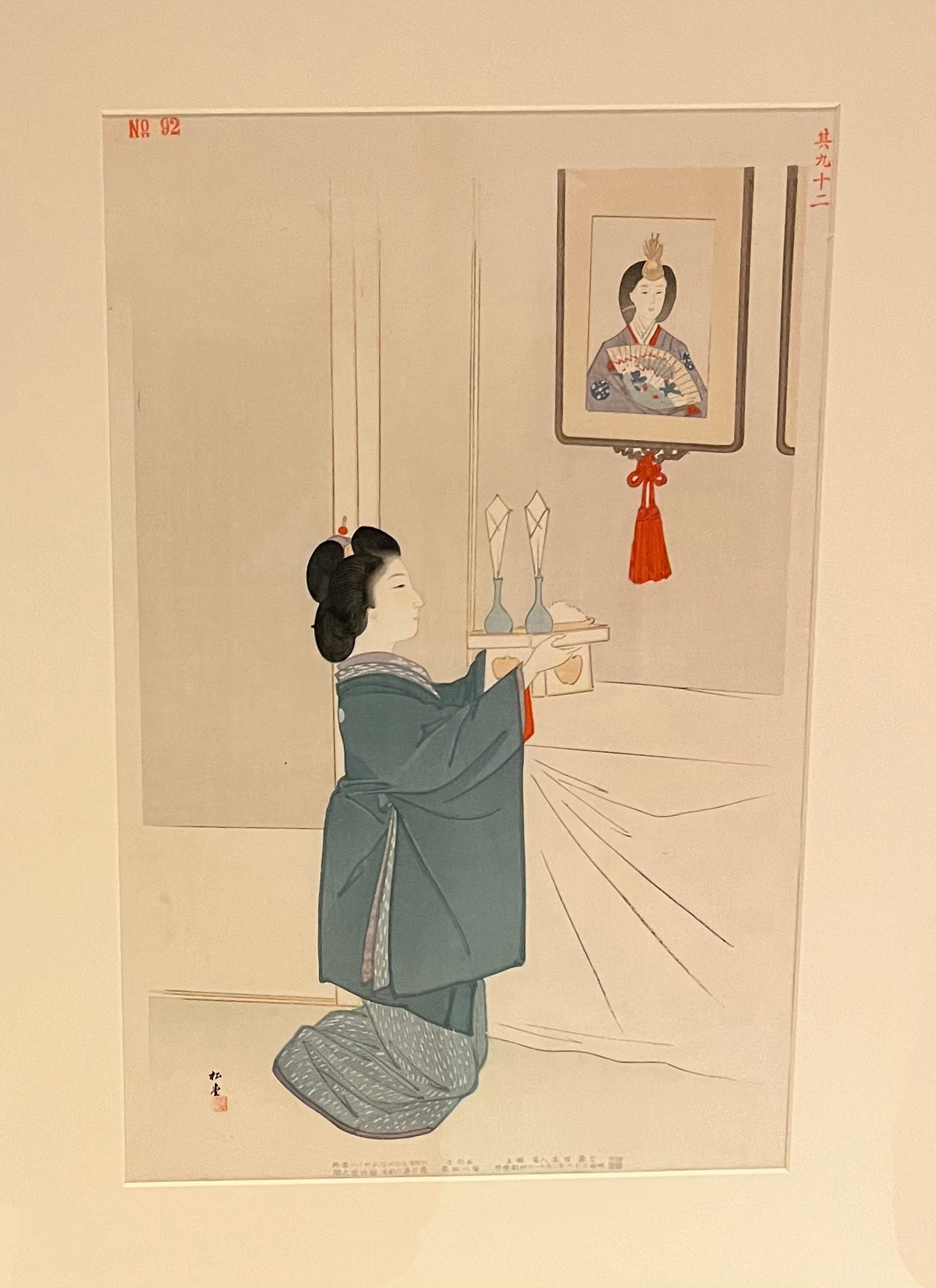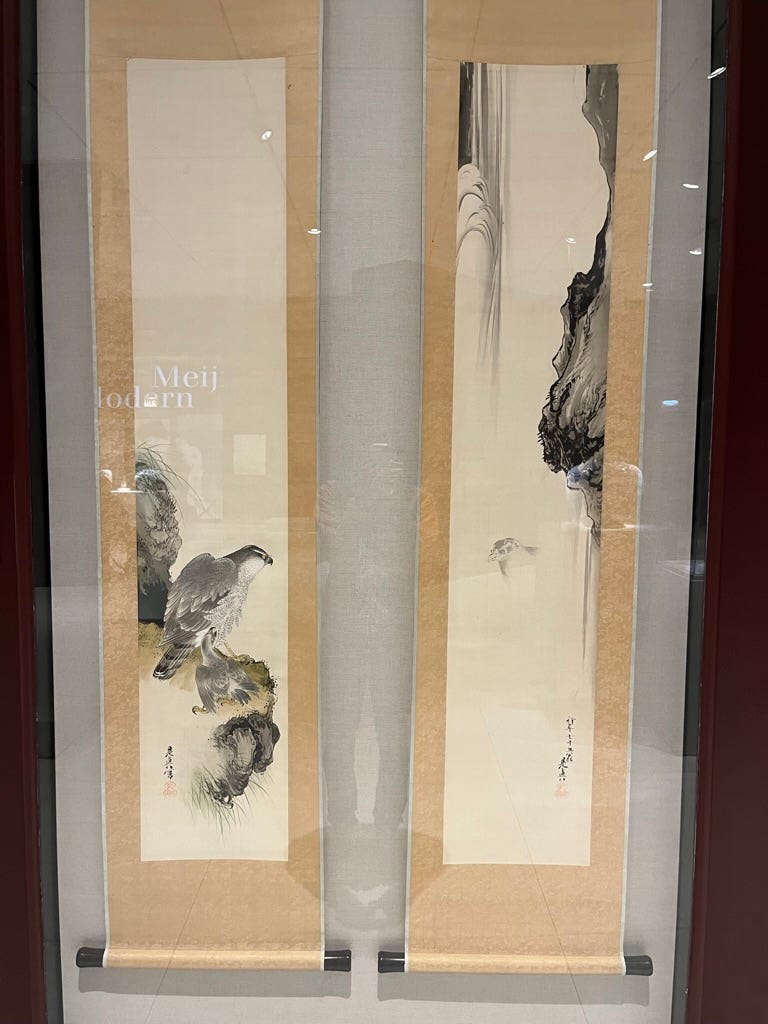Checking out Meiji art
Short review of exhibit ending soon at Smart Museum of Art
Short updates:
We’ll try to go to the Chicago Blues Festival on June 9, to see Buddy Guy playing Millennium Park on his final tour. The Millennium Park Summer Music Series also includes Seun Kuti on July 15 and Béla Fleck, Edgar Meyer & Zakir Hussain on July 22.
I also just found out about one of the Tuesdays on the Terrace concerts at the Museum of Contemporary Art is the jazz harpist Brandee Younger paying tribute to Alice Coltrane. This is on July 23. We saw her last summer at the Chicago Jazz Festival. I’m not sure how this works with Béla Fleck et al. above on the day before.
I’ll be doing some short posts to catch up to the music. See the bottom section for the first of my favorite albums released this month.
Smart Museum of Art is a museum on the University of Chicago campus in Hyde Park. They only open for special exhibits, and those exhibits happen during the school year.
The current exhibit is Meiji Modern: Fifty Years of New Japan, going through June 9—just 2 more weekends. The Meiji era (1868-1912) is when Japan opened up to the Western world after near isolation for most of the Edo period (1603-1868). This involved incorporating a lot of things from Europe and America—not just modern technology, but also how people dressed, how the government worked, and so on. So an obvious appeal of art from this era is the mishmash of Japanese and Western styles.
This is a poster for Mitsukoshi, which still exists as a big department store chain in Japan. This may look very Japanese, but when you look closely (with some background knowledge), you find that the bench is Art Deco, the woman’s hair-do is Western, and she’s wearing a ring, which wasn’t a thing in Japan before Meiji. Also, this is a pretty nice poster for a department store.
One thing that my wife and I found striking was the amount of nationalistic propaganda on display. A crucial part of Meiji was the modernization of Japanese military, which eventually led to Japan winning the Russo-Japanese War in 1905. It’s fair to say that Meiji paved the way for the imperial expansion of Japan leading up to WWII.

This is one of the tamer examples, with a woman making an offering to the picture of the empress, and implicitly, the picture of the emperor to the right. The Meiji-era government promoted Shinto as the official religion, especially the belief that the emperor is a living god. This meant that working for the good of Japan was a divine mission, which drove both what we now see as the good parts of Meiji, like adopting new technology, and what we now see as the bad parts, like taking over Korea.
Many of the art pieces in this exhibit are more about illustrating something about the history than about pure aesthetics, until you get to the last room. I imagine if you’re not particularly into Japanese history, this room would be the most enjoyable one. One thing you’ll see is this fun pair of hanging scrolls (above), where a hawk on the left is looking at its own reflection in the waterfall to the right.
In short, I saw something curious, something educational, and something beautiful, so I’d say this is a very good exhibit. If you miss this in Chicago, it’s going to Houston next.
Next on this newsletter is a guide to Hyde Park.
What I’m listening to now
Before my wife and I headed to Rome for our honeymoon in 20191, I spent a few months taking Italian courses at ItalCultura on Mag Mile and looked for some Italian music that I liked. This led me to artists like Fulminacci, who is Roman and got a lot more popular over the past 5 years, and Maria Antonietta, who was later hosting an Italian TV show about religious art—and seemingly cast perfectly for it2. Their latest albums at the time, La Vita Veramente and Deluderti, are both great albums top to bottom.
But I got even more into the band Selton. They are 3 Brazilians in Italy, playing a distinct mix of Brazilian music and European indie rock. Long-time readers may be able to tell that I have a soft spot for bilingual artists. They sing mainly in Portuguese and Italian, often in the same song, with some English mixed in.
The first song on their new album GRINGO Vol.1 is a cover of “Sangue Latino” (“Latin Blood” in Portuguese) by Secos & Molhados. I definitely recommend checking out the original from 1973, with Ney Matogrosso on vocals. You can also find some live versions on YouTube, and it’s a song where people start clapping seconds into the intro. For the cover, Selton added some Italian lyrics, and switches between the 2 languages repeatedly. They create a steady buildup to the final verse by Ney Matogrosso himself, who sings like he owns the song, which he does.
Another favorite for me is “Café Pra Dois” (“Coffee for Two”). It’s lighthearted indie pop with Brazilian rhythms, Selton’s bread and butter.
This wasn’t right after we got married. It’s good we decided to go then and not 2020.
Maria Antonietta is the Italian version of Marie Antoinette. She may be a history nerd.


